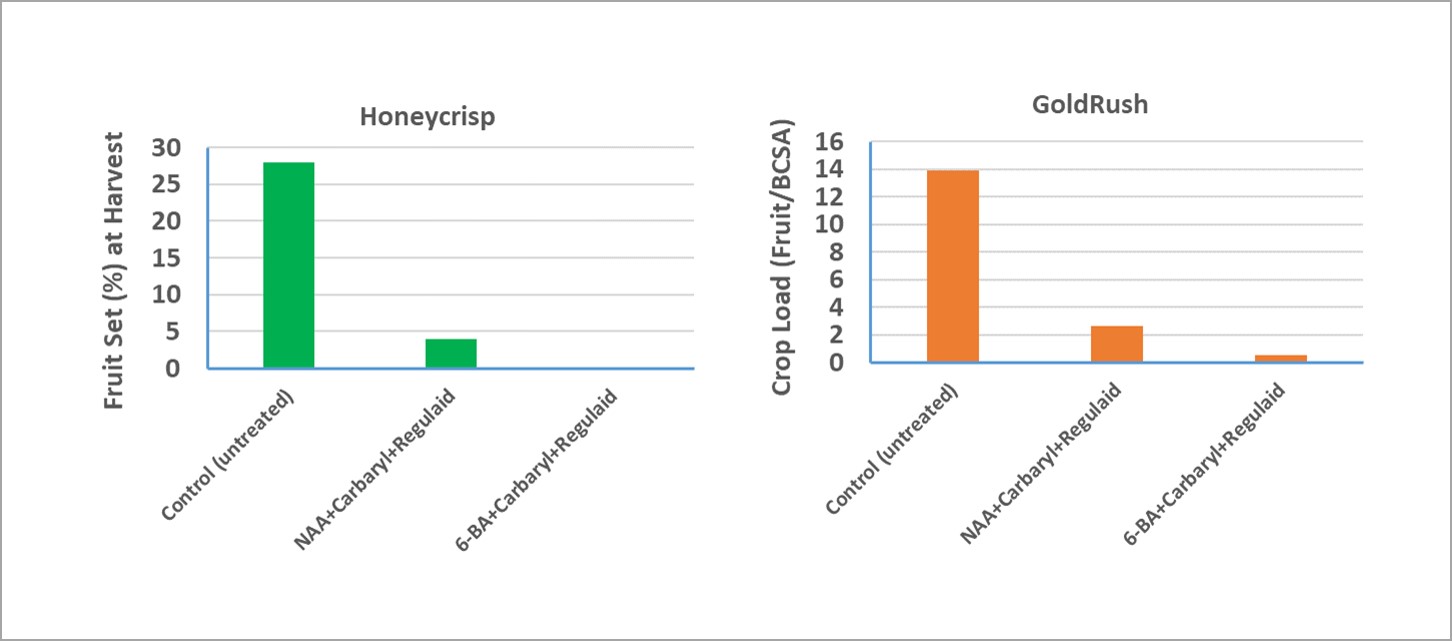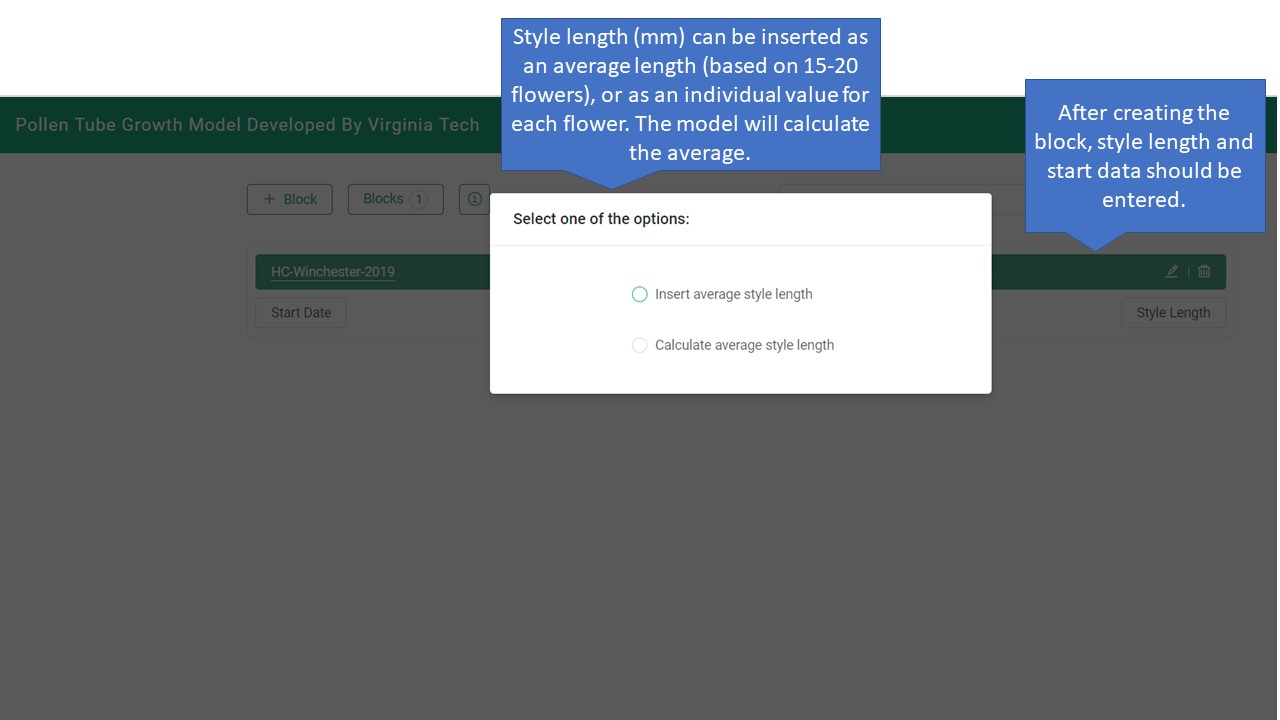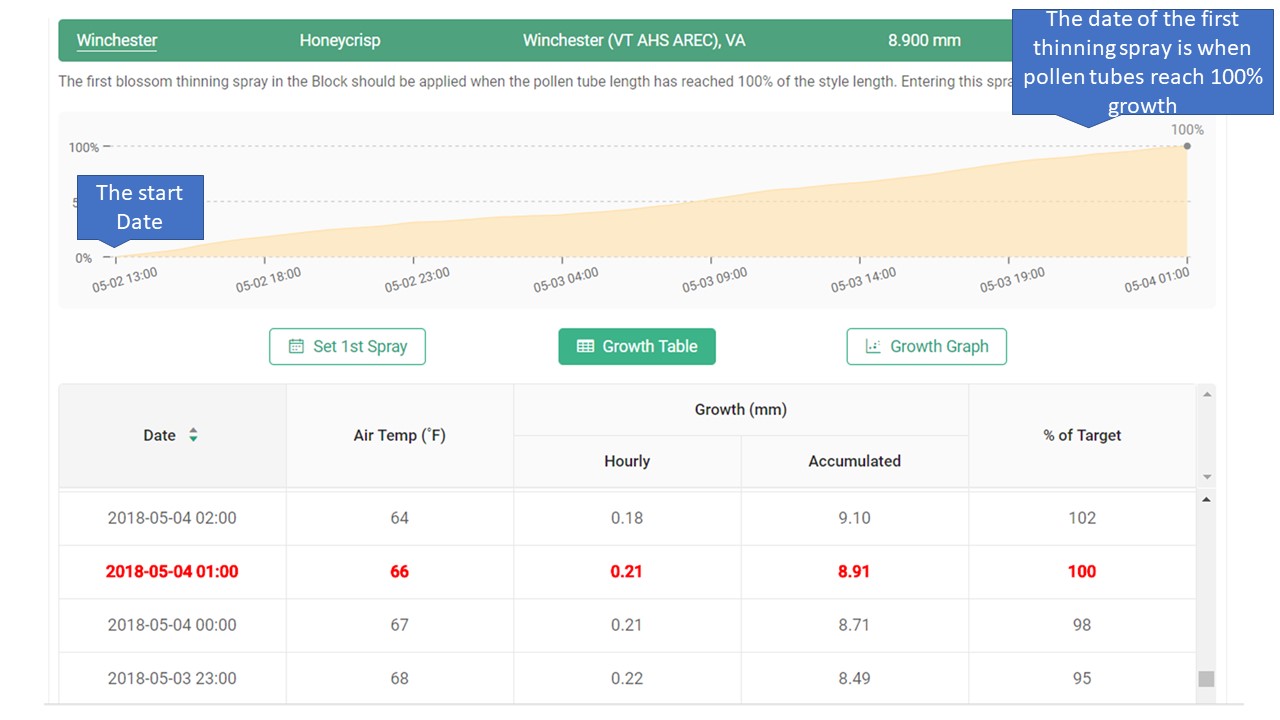If you are not done yet with your thinning sprays and feel that another application is needed, tomorrow, Tuesday-May 7, is another good chance for thinning. Fruit sizes for Gala, Pink Lady and Honeycrisp in Winchester are 12, 12.5 and 10.5 mm which are still within the recommended range for thinning with 6-BA/carbaryl or NAA/carbaryl mixes. Temperatures will drop to 65F this Wednesday making thinning with 6-BA and NAA a bit challenging. The addition of 1 pt/100 gal of oil (e.g. 70-sec superior, JMS Stylet oil) can help increase the response to thinning sprays. However, the addition of oil may cause russeting on some cultivars. Also, Captan should be avoided within 7 days of oil applications, as it may lead to sever russeting. As per the carbohydrate thinning model, the rates of chemical thinners should be increased by 15% for Wednesday applications to compensate for the potential increment in the tree carbohydrate level.
Apple Carbohydrate Thinning-Thursday 5/2/2019
If you are planning to apply thinning treatments tomorrow, Thursday, May 2, it’s recommended to decrease thinning rates by 15-30% based on the % of spurs that are flowering, as indicated below. It’s likely going to rain tomorrow afternoon. Allow 2-3 hours for the thinning sprays to be completely absorbed before the rain occurs.
A new Version of the Malusim Model on NEWA
The following is the message I received today from Dr. Terence Robinson, at Cornell University, regarding the 2019 version of the carbohydrate thinning model (aka; Malusim Model) on the NEWA website.
“We are pleased to announce the official release of the 2019 carbohydrate thinning model (Malusim) on the Newa website. The model will have an updated look and information. The input page will require growers to input the % of spurs that are flowering in one of 4 ranges (0-25, 26-50, 51-75 and 76-100%.). The output data table will have a column of DD base 4°C and will have colors highlighting when we are in the sweet spot for thinning (200-250DD from bloom). The new version will also give a Thinning Index composed of the average carb balance of 2 days before, the day of thinning and the next 4 days= 7 day running average. The thinning recommendations will be based on a new 3 dimensional lookup table taking into account, DD from bloom, % of spurs that are flowering and carb balance over 7 days. The thinning recommendation cells in the table will also be color coded to indicate red=high risk of overthinning, blue= mild thinning expected, yellow= caution possible aggressive thinning efficacy and green=good thinning efficacy.
We are pleased to announce the official release of the Malusim app, including an android and an iOS versions. You can download the app from the Google Play Store or the iTunes Store, OR use the app from any browser at https://malusim.org (note that speech recognition features are not supported in the browser version of the app).
IMPORTANT: If you used the 2018 beta version of the Malusim app for Android, you must uninstall it from your devices and download the new release from the Google Play Store. The data storage method has changed, and any changes you make to your data in the old app will not be accessible via the new app on any of the supported platforms.
You can continue to access any data that you entered last year – however, remember that when entering data for this year, you should clone any existing locations, rather than editing them and simply updating the year. Cloning will allow you to access data from previous years in the future”.
Good Thinning Conditions This Week
Cloudy and warm weather in the next three days (April 30-May 2) along with the tree carbohydrate status and average daily temperatures as shown in Figure 1 all predict an excellent response to chemical thinners this week. Due to carbohydrate deficits, the carbohydrate thinning model recommends reductions in thinning material rates by 15% for Tuesday and Wednesday applications to avoid over-thinning.
Figure 1: The carbohydrate thinning model and weather forecast for the week of April 29
Note: The fruit size averages for Pink Lady, Gala, and Honeycrisp in Winchester are 7.1 mm, 6.2 and 5.3 mm, respectively.
Carbohydrate Thinning Model-4-26-2019
The Figure below illustrates the model outputs for Gala in Winchester/Frederick County. I used the weather station in Winchester-AREC. However, the same outputs were obtained when I used Washington-Gadio Cellar weather station. For Central Virginia, the bloom date for Gala was April 16, so the model outputs are almost similar to that of Winchester.
Based on Winchester 10-day weather forecast and the outputs of the carbohydrate model, I would suggest Tuesday (April 30) or Wednesday (May 1) for fruit thinning sprays. The expected carbohydrate deficit on April 29 and the two cloudy/rainy days on May 2-4 predict high responsiveness to thinning materials, particularly 6-BA and NAA. The rates of thinning chemicals should be adjusted based on the degree of carbohydrate deficit after thinning applications. Therefore, I will rerun the model on Monday (April 29) to provide more recent information on thinning rates.
Fruit Thinning Scenarios-2019
According to the fruit size data I collected from our Pink Lady, Gala, Honeycrisp and Fuji trees in Winchester-AREC as appears below; we are in the stage of staring fruit thinning applications. I have attached two charts that you can use as a guide for your thinning treatments at petal fall-5mm, at fruit size (6-18 mm) and fruit size (19- 25 mm). I have also suggested application timings and treatments for return bloom applications that you may consider (Figures 1, 2), especially for Honeycrisp and Fuji. I will follow this post with another one for the carbohydrate thinning model recommendations.
Figure (1): Chemical Thinning and Return Bloom Recommendations for Honeycrisp, Gala and Fuji
Figure (2): Chemical Thinning and Return Bloom Recommendations for Golden Delicious, Idared, Ginger Gold, Pink Lady, and Red Delicious
Chemical Fruit Thinning: Prepare Your Arsenal.
The full bloom dates for Pink Lady, Gala, and Honeycrisp in Winchester are 4/16, 4/18 and 4/18, respectively. In Central Virginia, bloom dates for these varieties are 7-10 days earlier. So, it’s about the time to think about chemical fruit thinning options and prepare our arsenal. The following are tables summarizing the materials, rates, and timing for chemical fruit thinning in apples. More details will be provided through our in-orchard meeting in Central Virginia and the In-Depth meeting in Winchester this week. Also, I will run the carbohydrate thinning model and provide weekly updates on model outputs and thinning recommendations based on three weather stations: Batesville-for Central Virginia; Gadino Cellar-for Rappahannock/Madison area and VT-AHS AREC for Frederick County/Shenandoah Valley.
Table 1: Common chemical thinners, tradenames, and manufacturers.
Table 2: Effective thinning sprays at petal fall to 5 mm fruit diameter.
Table 3: Effective thinning sprays at 6-15 mm fruit diameter.
Table 4: Effective thinning sprays at 16 mm-25 mm fruit diameter.
Note: Application rates are based upon a concentrate spray volume of 100 gallons per acre and product labels at the time of publication. When applying chemical thinners use the rates indicated on the labels of the products that you are using. Always follow the label when applying chemical thinners. The degree of thinning actions are listed according to the author’personal field experience. The degree of thinning action may vary from orchard to orchard and block to block.
Chemical options for defruting young apple trees
Defruiting newly planted and young apple trees (e.g., 2nd and 3rd leaf) allows trees to fill their allotted bearing space, grow to the top wire and become ready to bear a decent crop by the fourth and fifth year. Although defruiting can be performed manually by removing flower clusters or by hand-thinning small fruitlets, many chemical options can make defruiting much more comfortable and less labor-dependent. These include:
a) Using blossom thinners: Two products of lime sulfur are now labeled for blossom thinning in Virginia. These are Rex lime sulfur and NovaSource lime sulfur. Two to three applications of lime sulfur at 3% (3 gallons/100 gallon per acre) mixed with oil (e.g., JMS Stylet-oil) at 2% will be enough to prevent the fertilization and fruit set of the majority of king and side blossoms. However, blossoms thinning sprays should be avoided when daytime temperatures are favorable for fire blight infections, e.g., between 75 to 85 oF, or when fire blight models (e.g., Maryblyt) predict blossom infections.
b) Using post-bloom thinners (recommended): chemical products containing 6-BA (e.g., Maxcel and Exilis 9.5SC) or NAA (e.g., Fruitone L, PoMaxa and Refine 3.5WSG) can be applied in combination with carbaryl (e.g., Sevin XL plus) to remove apple fruitlets. Two applications at fruit size 6-18 mm will be sufficient. 6-BA at 75-200 ppm or NAA at 10 ppm combined with carbaryl at 1 qt/100 gal/acre should achieve satisfactory results. However, it should be noted that NAA is not recommended for Fuji and Delicious. Defruiting with 6-BA or NAA will be more efficient if trees are under carbohydrate deficit conditions. The carbohydrate thinning model on NEWA (http://newa.cornell.edu/index.php?page=apple-thin) predicts the carbohydrate status of the tree based on daytime temperatures and solar radiation values. The best defruting conditions will be obtained if the model predicts a 4-day average balance of -40 to -80 g/day. If the model is not accessible, defruting sprays by 6-BA and NAA should be applied when daytime temperatures are ≥ 85 o. Cloudy days before and/or after defruting applications should also be targeted. Adding a non-ionic surfactant (e.g., Regulaid) to the spray tank will also enhance the efficacy of defruting applications.
The following figure shows the effect of two defruting treatments on fruit set (%) and crop load (fruit/branch cross-sectional area) of Honeycrisp and GoldRush trees, respectively. Treatments were applied twice at fruit size 6-18 mm.
c) Ethephon and carbaryl application: This combination will remove most fruit, but may cause tree growth reduction and increase flowering the following year. Use 1.0 to 1.5 pt of ethephon tank mixed with 1 qt of carbaryl and a surfactant or 1 qt of Superior oil/100 gal/acre. Apply when fruit are between 10 and 15 mm in diameter. Select a day when daytime high temperatures are expected to be between 70 and 90°F.
The Pollen Tube Growth Model for Blossom Thinning
Early season PGR and fertilizer applications for apples
Prohexadion calcium:
- Shoot growth reduction by prohexadione-calcium (PC) (Kudos and Apogee) early in the season (at Pink) significantly reduces bitter pit incidence by 45-54%.
- PC applications at pink also reduce the incidence of blossom blight and subsequent shoot blight.
- Considerations for applying PC:
- Use at the rate of 6 oz/acre.
- PC is not active at high pH levels: Use magnesium sulfate or water conditioner to lower the pH level.
- PC should not be mixed with calcium or boron.
- Adding a surfactant to the tank increases the efficiency of PC applications.
- Use anti-foam agent if the surfactant is one that foams.
- If the water source contains high levels of calcium carbonate (hard water), add ammonium sulfate (AMS).
- Both Kudos and Apogee are labeled for use at pink in apples.
Pink Lady (top) and Gala (bottom) flower buds on April 8, 2019.
Calcium applications:
- Between 15-50 pound of calcium chloride should be added per acre per year to reduce bitter pit incidence. In other words, 2-8 pound/cover spray.
- Calcium chloride should not be applied at temperatures above 85 o
- Early season applications of calcium are more important than late-season applications.
- Foliar applications of Ca nitrate are not recommended for Delicious and York. They might cause cork-spot like symptoms.
- Soil applications of Ca are not efficient.
- Ca nitrate contains 13.5% nitrogen and it might affect fruit coloration if nitrogen levels in the orchard are already high.
- Calcium content in fruit is largely affected by crop load, vigor control, and nutrient management.
- Fruits in the higher part of the canopy contain more Ca than those in the lower half of the tree.
- Boron deficiency may reduce Ca movement in the tree.
Boron applications:
– Boron is essential for Ca movement and Boron deficiency may lead to Ca-deficiency disorders including bitter pit.
- 3-4 lb/acre of solubor can be applied at tight cluster or pink/white stages; 7-10 after petal fall or with the first cover spray.
Nitrogen applications:
- The annual amount of nitrogen for mature apple trees in high-density planting is about 50-80 lb/acre. If the soil has 3% organic matter, this alone can contribute 30-40 lb/acre of nitrogen.
- Foliar application of urea early in the season at 3 lb/acre (prior to bloom) or 5-6 lb/acre (at petal fall) is beneficial for fruit set, early fruit growth, and leaf development.





























